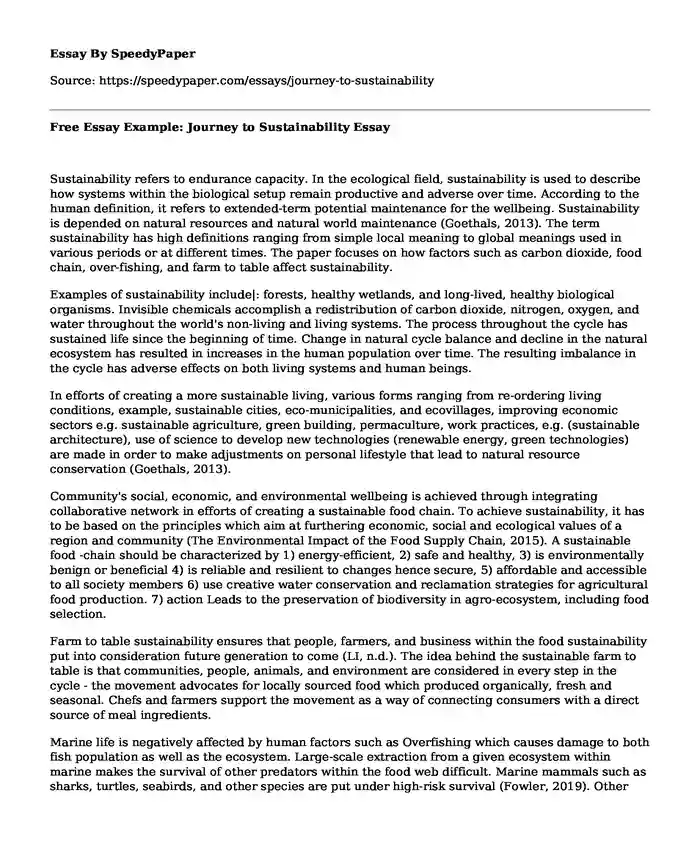Sustainability refers to endurance capacity. In the ecological field, sustainability is used to describe how systems within the biological setup remain productive and adverse over time. According to the human definition, it refers to extended-term potential maintenance for the wellbeing. Sustainability is depended on natural resources and natural world maintenance (Goethals, 2013). The term sustainability has high definitions ranging from simple local meaning to global meanings used in various periods or at different times. The paper focuses on how factors such as carbon dioxide, food chain, over-fishing, and farm to table affect sustainability.
Examples of sustainability include|: forests, healthy wetlands, and long-lived, healthy biological organisms. Invisible chemicals accomplish a redistribution of carbon dioxide, nitrogen, oxygen, and water throughout the world's non-living and living systems. The process throughout the cycle has sustained life since the beginning of time. Change in natural cycle balance and decline in the natural ecosystem has resulted in increases in the human population over time. The resulting imbalance in the cycle has adverse effects on both living systems and human beings.
In efforts of creating a more sustainable living, various forms ranging from re-ordering living conditions, example, sustainable cities, eco-municipalities, and ecovillages, improving economic sectors e.g. sustainable agriculture, green building, permaculture, work practices, e.g. (sustainable architecture), use of science to develop new technologies (renewable energy, green technologies) are made in order to make adjustments on personal lifestyle that lead to natural resource conservation (Goethals, 2013).
Community's social, economic, and environmental wellbeing is achieved through integrating collaborative network in efforts of creating a sustainable food chain. To achieve sustainability, it has to be based on the principles which aim at furthering economic, social and ecological values of a region and community (The Environmental Impact of the Food Supply Chain, 2015). A sustainable food -chain should be characterized by 1) energy-efficient, 2) safe and healthy, 3) is environmentally benign or beneficial 4) is reliable and resilient to changes hence secure, 5) affordable and accessible to all society members 6) use creative water conservation and reclamation strategies for agricultural food production. 7) action Leads to the preservation of biodiversity in agro-ecosystem, including food selection.
Farm to table sustainability ensures that people, farmers, and business within the food sustainability put into consideration future generation to come (LI, n.d.). The idea behind the sustainable farm to table is that communities, people, animals, and environment are considered in every step in the cycle - the movement advocates for locally sourced food which produced organically, fresh and seasonal. Chefs and farmers support the movement as a way of connecting consumers with a direct source of meal ingredients.
Marine life is negatively affected by human factors such as Overfishing which causes damage to both fish population as well as the ecosystem. Large-scale extraction from a given ecosystem within marine makes the survival of other predators within the food web difficult. Marine mammals such as sharks, turtles, seabirds, and other species are put under high-risk survival (Fowler, 2019). Other human factors such as deforestation and chemical production affect the carbon dioxide and oxygen balance resulting in survival difficulties.
Conclusion
Sustainability in ecology focuses on creating a natural balance between the living and non-living organisms. When an imbalance occurs within an environment, an impact is felt by not only the species affected directly but also by all microorganisms within the food web. The concept of sustainability ensures the current issues such as environment are first considered before any modification is done; it is the duty of human beings to be conservative on the environs to avoid adverse effects which may arise when some factors are not considered.
References
Fowler, C. (2019). Management of multi-species fisheries: from Overfishing to sustainability. ICES Journal of Marine Science, 56(6), 927-932. doi:10.1006/jmsc.1999.0535
Goethals, P. (2013). Sustainability of water quality and ecology: Easier said than defined and implemented. Sustainability of Water Quality and Ecology, 1-2, 1-2. doi:10.1016/j.swaqe.2014.08.001
The Environmental Impact of the Food Supply Chain. (2011). Handbook of Sustainability for the Food Sciences, 47-77. doi:10.1002/9780470963166.ch3
Cobb, J. B. (2007). Sustainability: Economics, ecology, and justice. Wipf and Stock Publishers. Retrieved from http://files.isec.pt/DOCUMENTOS/SERVICOS/BIBLIO/INFORMA%C3%87%C3%95ES%20ADICIONAIS/Industrial-Ecology-and-Sustainable-Engineering-International-Ed_Graedel.pdf
Cite this page
Free Essay Example: Journey to Sustainability. (2023, Feb 11). Retrieved from https://speedypaper.com/essays/journey-to-sustainability
Request Removal
If you are the original author of this essay and no longer wish to have it published on the SpeedyPaper website, please click below to request its removal:
- Literary Essay Sample on the Play Much Ado About Nothing
- Food & Drug Administration Court Cases Analysis, Free Essay
- Feminist Take on Kate Chopin's The Story Of An Hour. Essay Example
- The Cherokee Indians Essay Sample
- Paper Example: Wonderful World of WiFi
- Essay Sample on Blood Test: Uric Acid, Antinuclear Antibodies Direct
- Essay Example: Inductive and Deductive Reasoning
Popular categories





